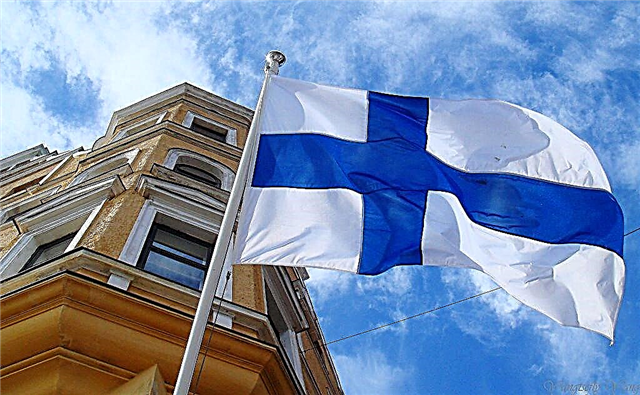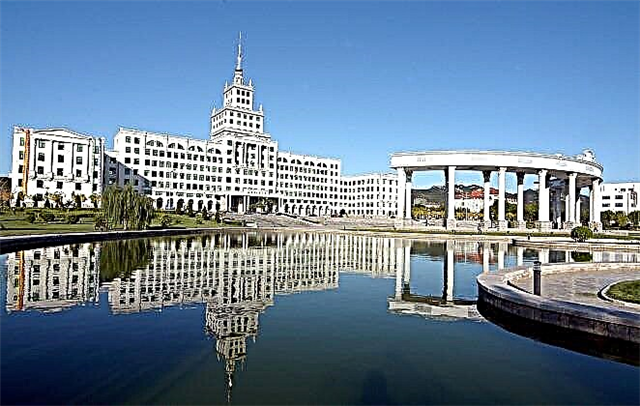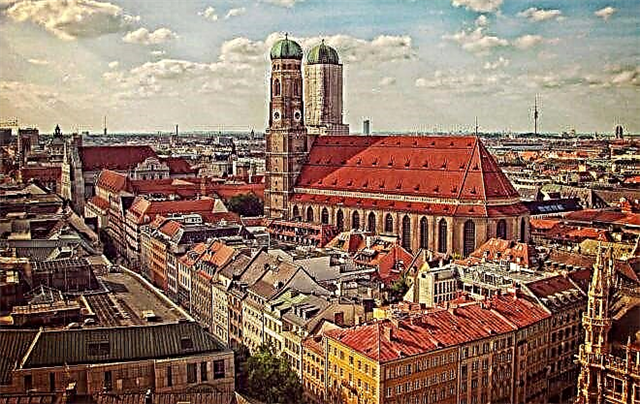Frauenkirche Cathedral in Munich (German Frauenkirche) is a tourist symbol of Bavaria and the greatest architectural monument in Germany. The official name is the Cathedral of the Blessed Virgin Mary (German Der Dom zu Unserer Lieben Frau). The temple is located near the central square of Marienplatz, and its towers offer panoramic views of the city. Since the 15th century, the late Gothic church has been considered the main attraction in Munich.
About Frauenkirche in Munich
Frauenkirche Cathedral is an active Catholic church in the Diocese of Freising and Munich. The cathedral was built as a result of the secularization of the bishopric and the merger of the parish and collegiate church under the Wittelsbachs and is a symbol of the political power of the dynasty, the personification of the union of the throne and religion.
In 2004, the authorities decided not to erect buildings higher than the Frauenkirche in Munich in order to preserve its cultural and architectural value.
Munich Cathedral of the Blessed Virgin Mary is the oldest patron saint church in the diocese and the tallest building in the city. The height of the towers is 98.5 m, the length of the nave is 109 m, and the height is 40 m.
Cathedral history
The construction of the Church of the Blessed Virgin Mary is closely related to the rule of the Wittelsbach dynasty (German: Wittelsbacher). To strengthen his position on the throne, Duke Sigismund decided to build a new parish church. Subsequently, it became the family crypt, in the crypt of which the rulers of Bavaria and the Palatinate are buried.
The temple never belonged to the people, but was a symbol of the Wittelsbachs.
Prior to that, their family church was considered the Marienkirche, around which Der Dom zu Unserer Lieben Frau was built. The Frauenkirche can accommodate 20 thousand parishioners, although at the time of construction, the population in Munich did not exceed 13 thousand inhabitants.
Frauenkirche construction stages
The construction of the temple began in 1468. The project was carried out by the renowned architect Jörg von Halspach, who supervised the construction of the Old Town Hall on Marienplatz.
- In 1494, the main facade was erected, the cathedral was consecrated and opened to parishioners. The architect himself did not live to see the end of construction.
- Further work was carried out until 1525. The last to be erected were the domes and towers.
- In 1599, a triumphal arch, decorated with stucco molding, was additionally erected in the temple, and in 1620 the image of the "Assumption of the Blessed Virgin Mary" appeared on the main altar.
- In 1821, the cathedral became the episcopal residence, which led to a radical reorganization of the interior.
- After World War II, the church was badly damaged. In 1989-1994. a complete reconstruction of the temple was carried out.
Features of the architecture of the cathedral: exterior and interior
In the 15th century in Germany, it was believed that the Renaissance and Baroque were more suitable for secular architecture, and religious buildings should be in the Gothic style. Therefore, the church is a laconic brick structure in the late Gothic style with elements of eclecticism and baroque.
The main part of the Cathedral of the Blessed Virgin Mary was built in 20 years. Then the construction was suspended due to lack of funds, which affected the architecture of the temple, where several styles and directions are combined.
The Frauenkirche is a five-nave cathedral without a transept with two towers. Inside, there are 22 massive columns supporting the roof. They visually hide the space, so it may seem that the capacity of the church is less than it actually is.
Initially, it was planned to decorate the domes with spiers, as in the Cologne Cathedral, but under the influence of architectural trends of the Renaissance, this idea was abandoned.
The Frauenkirche design is borrowed from the Church of the Holy Sepulcher in Jerusalem, made according to Byzantine designs. This created a striking contrast against the austere Gothic backdrop.
When Frauenkirche became an episcopal cathedral, the interior design of the temple changed, in particular, its altar part.
What the walls of the temple hide: shrines and relics
The history of the Frauenkirche spans five centuries, but its construction is still shrouded in secrets and legends. At the time of construction, similar structures did not exist in Bavaria. Especially questions were caused by the rapid construction of the church in 20 years, which was an incredibly short time for such a construction.
The Cathedral of the Blessed Virgin Mary is not only an amazing example of late Gothic, but also a valuable cultural heritage of Germany, the walls of which keep more than one secret.
Monument to the Wittelsbachs - cenotaph of Ludwig IV
An important part of the Frauenkirche is sculpture. In the south wing there is a cenotaph, erected in 1622 at the initiative of Elector Maximilian I in honor of the deceased Emperor Ludwig of Bavaria. The cenotaph is intended to emphasize the importance of Ludwig IV for the Catholic faith, because in the history of the rule of the Wittelsbach dynasty, he occupies a central place.
Inside the marble crypt is a Gothic plaque. However, the authorship of the slab has not yet been established. The remains of the ruler himself are not here, since he is buried in the crypt along with the rest of the monarchy.
Near the monument are two bronze statues of Duke William IV (1508-1550) and Albrecht V (1550-1579), as well as four kneeling banner-bearers, creating a single sculptural composition.
Teufelstritt - the devil's trail
The Cathedral of the Blessed Virgin Mary is an atypical religious building in 15th century Bavaria. Its architecture has inspired many myths that have been passed down by the locals from generation to generation. The most famous of these is der Teufelstritt or the devil's footprint.
At the entrance to the cathedral there is a footprint on the floor, according to legend, left by Lucifer himself. During the construction of the Frauenkirche, a deal was allegedly made between the architect and the devil: Satan promised to help in the construction of the church in exchange for the architect's soul.
At that time, there were an abundance of religious buildings in Munich. Satan was afraid that the patronage of the Blessed Virgin Mary would weaken his position, so he decided to make a temple that would not attract parishioners.
When the building was completed, the devil came for a debt. Entering through the main gate, he laughed, because there was not a single window inside, which means that such a temple could not be useful. With joy, the demon kicked the floor, leaving its imprint on it. But when he took another step, he saw light falling through the glass. In anger, he turned into the wind and tried to break the windows, which failed as people entered the church in droves.
Indeed, at the entrance to the church, the side windows are not visible. From 1622 to 1860 they were obscured by a huge Renaissance altar with the image of the Assumption of the Blessed Virgin Mary, made by P. Candide.
There is another legend of the Frauenkirche cathedral, according to which the devil in the guise of a storm is still trying to get inside and break the windows, so it is always windy around the temple.
An echo of the origins of Catholicism - mechanical watches
Accurate timing has become a necessary part of Western religion since the Middle Ages. Services began at the same time, for which clocks were set in churches. They not only determined when to begin prayer, but also symbolized praise to God and the transience of life.
A unique mechanical clock is installed in the cathedral, which shows a puppet show - the intercession of Jesus and Mary before God the Father.
Also, the dial shows the solar system, lunar phases, signs of the zodiac.
In 1749, during the restoration, a crowing rooster was installed in the clockwork. But under the influence of different eras, the watch case changed several times, so they have not survived in their original form. Today, the built-in musical accompaniment remains, which makes the whole structure unique.
Frauenkirche Crypt - Crypt of the Wittelsbach Dynasty
Outside the walls of the central altar there is a crypt - the burial place of monarchs, archbishops and cardinals. The Frauenkirche Crypt is a family crypt where the remains of the rulers of the Wittelsbach dynasty are buried.
Each grave is framed in a tomb with a memorial plate. The room is made of brick and does not differ in lush decoration, although back in the 19th century the crypt was decorated with bas-reliefs, paintings, stucco moldings, which were removed after reconstruction. Tourists are not allowed to enter this part of the temple.
Opening hours and visit to the cathedral
The cathedral is open daily from 7.30 am to 8.30 pm. There are restrictions on tourists visiting the temple during church services. Parish office opening hours:
- from 8.30 to 12.30;
- from 14.00 to 16.30 from Monday to Thursday;
- from 8.30 am to 12.30 pm on Friday.
Sightseeing tours are held on Sundays from May to September and at 15.00 on Thursdays. The entrance to the towers is temporarily closed: reconstruction work is underway.
The schedule of excursions, as well as the upcoming events that are held in the temple, are available on the official website.
How to get to the cathedral: route and address
Frauenkirche is located close to the central Marienplatz at Frauenplatz 12. The Marienplatz (Theatinerstraße) stop is nearby. You can get there by metro or city train, as well as by public transport 19 and N19.
The churches of Munich - the spiritual heritage of Bavaria
Religious buildings are key attractions in Munich. Each church is an echo of a certain era, which is reflected in the architectural style of the buildings. Although the Frauenkirche in Munich occupies the central place among the religious buildings of Bavaria, the following temples are no less significant in the history of the region:
| Official name | Years of construction, architectural style, confession |
|---|---|
| Azamkirche (German Asamkirche) or Church of St. John of Nepomuk | 1733-1746, Baroque, Catholicism |
| Church of St. Luke (German Lukaskirche) | 1893-1896, Romanesque style with Gothic elements, Protestantism |
| Church of St. Mark (German St. Markus) | 1873-1876, neo-gothic, lutheranism |
| Church of St. Michael (German Jesuitenkirche St. Michael) | 1583-1597, Renaissance architecture, Catholicism |
| St. Peter's Church (German. Peter) or "Alter Peter" | 1181, Romanesque, Catholic |
| Theatinerkirche | 1663-1690, Baroque, Catholic |
Conclusion
Frauenkirche Cathedral is a Gothic palace, a family crypt and a valuable architectural monument of the 15th century, which attracts tourists from all over the world. Not a single photo will convey the atmosphere of mystery of this place. Here the history of the greatest dynasty is hidden and the original culture of Bavaria is reflected.











